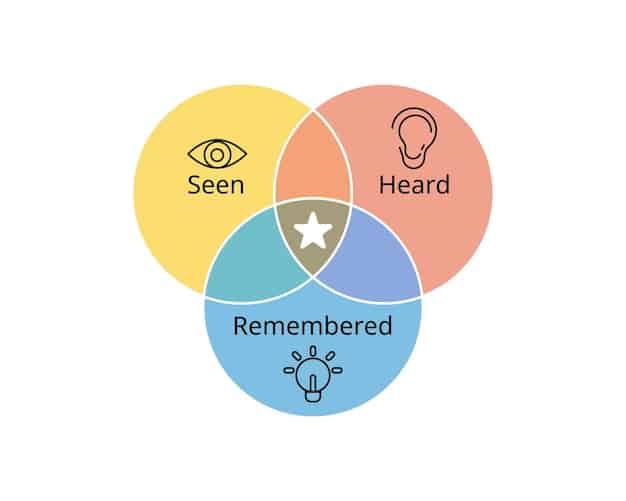Debunking The Myth of the Learning Styles

The Myth of the learning styles refers to the disproven belief that individuals learn best when instruction is tailored to their specific learning style, such as visual, auditory, or kinesthetic.
Have you ever been told that you’re a “visual learner” or an “auditory learner,” and that you should tailor your study habits accordingly? This idea, known as the myth of the learning styles, is pervasive in education, but research consistently shows it’s not based on solid evidence.
What Are Learning Styles?
Learning styles are the idea that different people learn information in different ways. The most common categorization splits learners into visual, auditory, reading/writing, and kinesthetic (VARK) styles.
Advocates for learning styles suggest that tailoring teaching methods to these styles improves learning outcomes. However, the scientific evidence tells a different story.

The VARK Model Explained
The VARK model, developed by Neil Fleming, suggests four primary learning styles:
- Visual Learners: Prefer using pictures, images, and spatial understanding.
- Auditory Learners: Learn best through sound and music.
- Reading/Writing Learners: Prefer learning through words, both written and read.
- Kinesthetic Learners: Learn through experience and practice, moving, touching, and doing.
While this model is intuitive, its practical application in improving learning outcomes is questionable.
Many educators and students believe in learning styles, but the belief doesn’t hold up to scientific scrutiny. The idea that people learn best when taught in their preferred style clashes with research findings.
Why the Learning Styles Theory Is a Myth
Despite its popularity, numerous studies debunk the notion that matching teaching methods to learning styles improves educational outcomes. Here’s why:
The learning styles theory lacks empirical support. Studies have consistently failed to demonstrate that aligning teaching methods with supposed learning styles leads to better learning.
Lack of Scientific Evidence
One comprehensive review of the literature, published in “Educational Psychology Review,” found little evidence to support the efficacy of learning styles. The review analyzed numerous studies and concluded that there is no significant benefit to tailoring instruction to individual learning styles.
Another review, “Learning Styles: Concepts and Evidence,” came to similarly skeptical conclusions. The authors argued that while the idea of learning styles is appealing, it lacks the rigor necessary to be considered a valid educational strategy.
- Inconsistent Results: Studies attempting to validate the theory often produce inconsistent or contradictory results.
- Methodological Flaws: Many studies suffer from methodological issues, such as small sample sizes or lack of control groups.
- Overlapping Preferences: Many individuals don’t fit neatly into a single learning style, exhibiting preferences across multiple categories.
The lack of scientific evidence is a significant blow to the myth of learning styles. If the theory doesn’t hold up under scrutiny, its practical application is questionable.
Instead of focusing on learning styles, educators should concentrate on evidence-based practices that have been proven to enhance learning, such as active learning and spaced repetition.
The Dangers of Believing in Learning Styles
While the learning styles theory might seem harmless, it can lead to several negative consequences. Believing in learning styles may limit students’ perceptions of their abilities and hinder their development of diverse learning strategies.
Over-identification with a specific learning style can result in a fixed mindset, where students believe they can only learn effectively through one particular method.

Limitations and Misconceptions
Here are some of the limitations and misconceptions associated with learning styles:
- Fixed Mindset: Students may believe they can only learn effectively through their identified style.
- Limited Exposure: Students might avoid challenging themselves with different learning methods.
- Ineffective Strategies: Teachers may waste time and resources tailoring instruction to unvalidated learning styles.
These limitations can prevent students from developing a well-rounded skill set and adapting to different learning environments.
Adopting a more flexible and open approach to learning can help students develop critical thinking skills and adapt to various learning environments more effectively.
What Does the Research Say?
Extensive research has consistently failed to support the learning styles theory. Studies that attempt to validate the theory often yield inconsistent or negative results.
Many well-designed studies have found no significant difference in learning outcomes when instruction is tailored to individual learning styles.
Key Studies Debunking Learning Styles
Several prominent studies have questioned the validity of learning styles:
- “Learning Styles: Concepts and Evidence” by Pashler et al. (2008): This review found no evidence to support the use of learning styles in education.
- “The Problem With Learning Styles” by Willingham et al. (2015): This article argues that the concept lacks empirical support and that teaching should focus on content rather than style.
- Numerous meta-analyses: Consistently show no benefit to matching instruction to learning styles.
These studies highlight the importance of evidence-based practices in education and the need for critical evaluation of popular educational theories.
The scientific consensus is clear: Learning styles do not significantly impact learning outcomes. Educators should prioritize strategies backed by solid research.
Effective Alternatives to Learning Styles
Instead of focusing on learning styles, educators and students should embrace evidence-based strategies that have been proven to enhance learning. Adaptive teaching, active learning, and metacognition are some examples.
Adaptive teaching involves adjusting teaching methods to accommodate the specific needs of learners, rather than adhering to fixed learning styles. This approach is flexible and responsive to individual student needs.
Evidence-Based Strategies
Here are some effective alternatives to learning styles:
- Adaptive Teaching: Adjusting teaching methods based on student progress and understanding.
- Active Learning: Engaging students through activities, discussions, and problem-solving.
- Metacognition: Encouraging students to reflect on their own learning processes.
These strategies are grounded in research and have demonstrated effectiveness in improving learning outcomes.
Adopting these strategies can create a more dynamic and effective learning environment for all students, promoting deeper understanding and retention.
Practical Implications for Educators and Learners
Understanding the myth of learning styles has significant implications for educators and learners alike. It’s essential to move away from unvalidated theories and embrace approaches grounded in solid research.
Educators should focus on implementing evidence-based practices, such as active learning, adaptive teaching, and metacognitive strategies, to create a more effective learning environment.
Moving Forward
Here are some practical steps for educators and learners:
By shifting away from the myth of learning styles, educators and learners can unlock new possibilities for learning and achievement.
Creating a more effective and inclusive learning environment through evidence-based teaching and critical thinking is critical for educational success.
| Key Point | Brief Description |
|---|---|
| 💡 Learning Styles Myth | The idea that tailoring instruction to individual “learning styles” improves outcomes is unsupported. |
| 🔬 Lack of Evidence | Research consistently fails to show a significant learning benefit from matching teaching to perceived learning styles. |
| 🧠 Adaptive Teaching | Adjusting teaching to student progress & needs, not fixed learning styles improves learning. |
| 📚 Active Learning | Engaging students actively instead of adhering to rigid learning style preferences shows better results. |
Frequently Asked Questions
▼
Learning styles are the idea that individuals learn best through specific methods such as visual, auditory, reading/writing, or kinesthetic. This theory suggests tailoring teaching to these styles enhances learning.
▼
The learning styles theory lacks solid scientific evidence. Research has repeatedly shown that matching teaching methods to perceived learning styles does not significantly improve learning outcomes.
▼
Effective alternatives include adaptive teaching, which adjusts instruction based on student progress, active learning, involving students in activities and discussions, and metacognition, or reflection on learning processes.
▼
Educators can move beyond learning styles by focusing on evidence-based teaching practices, adapting their methods to suit individual student’s needs rather than adhering to predetermined learning style categories.
▼
Believing in learning styles may lead to a fixed mindset where students think can only learn one way, limiting their ability to adapt to diverse learning environments and develop diverse skills.
Conclusion
In conclusion, the myth of the learning styles has been debunked by extensive research. Embracing evidence-based practices and adaptive teaching methods is crucial for enhancing learning outcomes and fostering a more effective and inclusive educational environment.





